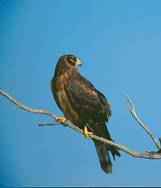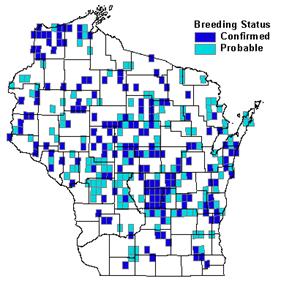Photo by Jack Bartholmai


Status/Protection
- Global Rank: G5 Key to global and state ranks
- State Rank: S2N, S3B
- WBCI Priority: SGCN, PIF, Special Concern
Population Information
Federal BBS information can be obtained at http://www.mbr-pwrc.usgs.gov/bbs/bbs.html by clicking on Trend Estimates and selecting the species in question. All estimates are for 1966-2005.
- Federal Breeding Bird Survey: significant decline
- Federal Breeding Bird Survey (WI): non-significant increase
- Federal Breeding Bird Survey (BCR 23): non-significant increase
- Federal Breeding Bird Survey (BCR 12): non-significant increase
- WSO Checklist Project: increasing (1983-2007)
Life History
- Breeding Range: Throughout Alaska and Canada east across the Great Basin and Great Plains states to the northern Atlantic Coast (MacWhirter and Bildstein 1996).
- Breeding Habitat: Idle Cool-season Grasses, Idle Warm-season Grasses, Dry-mesic Prairie, Wet-mesic, Prairie, Pastures, Hay, Oak Opening, Northern Sedge Meadow and Marsh, Southern Sedge Meadow and Marsh, Open Bog-Muskeg.
- Nest: Ground, typically within patches of dense, often tall vegetation in undisturbed areas.
- Nesting Dates: Eggs: late April to early August (Robbins 1991).
- Foraging: Low Patrol.
- Migrant Status: Short-distance migrant.
- Habitat use during Migration: Wetlands and uplands.
- Arrival Dates: March.
- Departure Dates: August to November.
- Winter Range: S. Canada to Mexico Winter Habitat: Open habitats without shrubs or trees.
Habitat Selection
Northern Harriers occur in undisturbed upland and wetland areas such as hayfields, pasture, medium to tall idle grasslands, old field, mesic to wet-mesic prairie, oak savanna, sedge meadow, and barrens. They favor larger grassland patches, typically >40 hectares (Sample and Mossman 1997, Johnson and Igl 2001). Northern Harriers are ground nesters and are known to nest near tall or dense patches of vegetation. In one Wisconsin study, dominant plant species near nests included willow (Salix sp.), grasses (Graminae), meadowsweet (Spirea alba), goldenrod (Solidago sp.), sedge (Carex and Scirpus spp.), and stinging nettle (Urtica dioica) (Hamerstrom and Kopeny 1981). Prey availability is also associated with habitat quality for this species. High prey abundance is positively correlated to productivity (Hamerstrom 1979).
Habitat Availability
Barrens, sedge meadow, idle grassland, and oak savanna habitats are currently rare in Wisconsin and vulnerable to conversion, development, and forest succession. Pastures and old fields are more common, but still vulnerable to heavy grazing or row crop conversion. The extensive grass meadows and marshes that this species favors are numerous only in the southern, eastern, and central portions of the state (Robbins 1991).
Population Concerns
Breeding Birds Survey data suggest significant population declines range-wide for this species. In Wisconsin, populations appear more stable (Sauer et al. 2005) and it remains a common migrant and resident throughout much of the state (Robbins 1991). During the six-year period (1995-2000) of the Wisconsin Breeding Bird Atlas, observers documented Northern Harriers breeding in 57 counties (Everard 2006).
In North America, the Northern Harrier experienced population declines in the twentieth century due mostly to loss of habitat through extensive wetland draining, monotypic farming, and the reforestation of farmlands. Factors affecting local winter-population densities include prey availability, snow cover, temperature, and competition with other raptors (MacWhirter and Bildstein 1996).
Recommended Management
Northern Harriers in Wisconsin will benefit from continued large-scale grassland restoration and management within appropriate ecological landscapes (Sample and Mossman 1997, Knutson et al. 2001). Areas managed for Greater Prairie-Chickens, another area-sensitive species, have provided breeding habitat for large numbers of harriers (Knutson et al. 2001). Wetland protection efforts for waterfowl and upland game bird management also will benefit Northern Harriers. Some of the conservation practices permitted by the Conservation Reserve Program (CRP) such as establishment of warm-season grasses and legumes and re-establishment of tilled wetlands can be beneficial to Northern Harriers. CRP participants should be encouraged to maintain CRP-approved vegetation after contracts expire (Hands et al. 1989).
Northern Harriers prefer idle habitats for nesting (Toland 1986, Herkert 1996), thus maintaining a mosaic of treated and untreated grasslands and wetlands is important (Johnson et al. 1998). No more than one-third of large areas (>40 hectares) should be burned in a given year (Sample and Mossman 1997). Avoid management activities during the breeding season, approximately April – July (MacWhirter and Bildstein 1996). Conservation and management strategies for this species should be focused in the following Wisconsin ecological landscapes: Central Sand Hills, Central Sand Plains, North Central Forest, Northern Lake Michigan Coastal, Northwest Lowlands, Northwest Sands, Southeast Glacial Plains, Southwest Savanna, Western Coulee and Ridges, and Western Prairie (WDNR 2005). Within these landscapes, the best public lands to manage for area sensitive species, such as the Northern Harrier, are White River Marsh Complex, Buena Vista/Leola Grasslands Landscape, and the Crex Meadows/Fish Lake Complex (Sample and Mossman 1997).
Research Needs
Much remains to be learned about the Northern Harrier outside the breeding season. Communal roost monitoring would provide considerable information regarding the distribution of sexes and the stability of wintering populations (MacWhirter and Bildstein 1996). Research is needed to determine the minimum size of habitat blocks needed to satisfy the requirements of harriers during the breeding, migratory, and wintering periods (Hands et al. 1989).
Information Sources
- Knutson, M.G., G. Butcher, J. Fitzgerald, and J. Shieldcastle. 2001. Partners in Flight Bird Conservation Plan for The Upper Great Lakes Plain (Physiographic Area 16). USGS Upper Midwest Environmental Sciences Center in cooperation with Partners in Flight. La Crosse, WI.
- Managing Habitat for Grassland Birds: A Guide for Wisconsin: http://www.npwrc.usgs.gov/resource/birds/wiscbird/
- North American Breeding Bird Survey: http://www.npwrc.usgs.gov
- Temple S.A., J.R. Cary, and R. Rolley. 1997. Wisconsin Birds; A Seasonal and Geographical Guide. Wisconsin Society of Ornithology and Wisconsin Department of Natural Resources, Madison, WI.
- Wisconsin Breeding Bird Atlas: www.uwgb.edu/birds/wbba/
- David Sample, Grassland Community Ecologist, Wisconsin DNR - 608-221-6351.
References
- Everard, J.O. 2006. Northern Harrier. In Atlas of the Breeding Birds of Wisconsin. (N.J. Cutright, B.R. Harriman, and R.W. Howe, eds.). The Wisconsin Society for Ornithology, Inc. 602pp.
- Hamerstrom, F. 1979. Effect of Prey on Predator: Voles and Harriers. Auk 96:370-374.
- Hamerstrom, F. and M. Kopney. 1981. Harrier Nest-Site Vegetation. Raptor Research 15(3):86-88.
- Hands, H.M., R.D. Drobney, and M.R. Ryan. 1989. Status of the Northern Harrier in the northcentral United States. U.S. Fish and Wildlife Service, Twin Cities, Minnesota. 18pp.
- Herkert, J.R., S.A. Simpson, R.L. Westmeier, T.L. Esker, and J.W. Walk. 1996. Response of Northern Harriers and Short-eared Owls to grassland management in Illinois. Abstracts of the 114th Stated Meeting of the American Ornithologists’ Union and 1996 Annual Meeting of the Raptor Research Foundation.
- Johnson, D.H. and L.D. Igl. 2001. Area Requirements of Grassland Birds: A Regional Perspective. Auk 118(1):24-34.
- Johnson, D.H, L.D. Igl, A. Dechant, M.L. Sondreal, C.M. Goldade, M.P. Nenneman, and B.R. Euliss. 1998. Effects of management practices on grassland birds: Northern Harrier. Northern Prairie Wildlife Research Center, Jamestown, ND. 12pp.
- Knutson, M.G., G. Butcher, J. Fitzgerald, and J. Shieldcastle. 2001. Partners in Flight Bird Conservation Plan for The Upper Great Lakes Plain (Physiographic Area 16). USGS Upper Midwest Environmental Sciences Center in cooperation with Partners in Flight. La Crosse, WI.
- MacWhirter, R.B., K. Bildstein. 2000. Northern Harrier (Circus cyaneus). In the Birds of North America, No. 511 (A. Poole and F. Gill eds.). The Birds of North America, Inc., Philadelphia, PA.
- Robbins, S. D., Jr. 1991. Wisconsin Birdlife: Population and distribution past and present. Madison, WI: Univ. Wisconsin Press.
- Sample, D. and M. Mossman. 1997. Managing Habitat for Grassland Birds: A Guide for Wisconsin. Wisconsin Department of Natural Resources: Madison, WI.
- Toland, B.R. 1986. Nesting ecology of Northern Harriers in Southwest Missouri. Transactions of the Missouri Academy of Science. 20:49-57.
- Wisconsin Department of Natural Resources. 2005. Wisconsin’s Strategy for Wildlife Species of Greatest Conservation Need. Madison, WI.
Contact Information
- Compiler: Jenny Herrmann, mherrmann4@wi.rr.com
- Editor: Kim Kreitinger, K.Kreitinger@gmail.com
